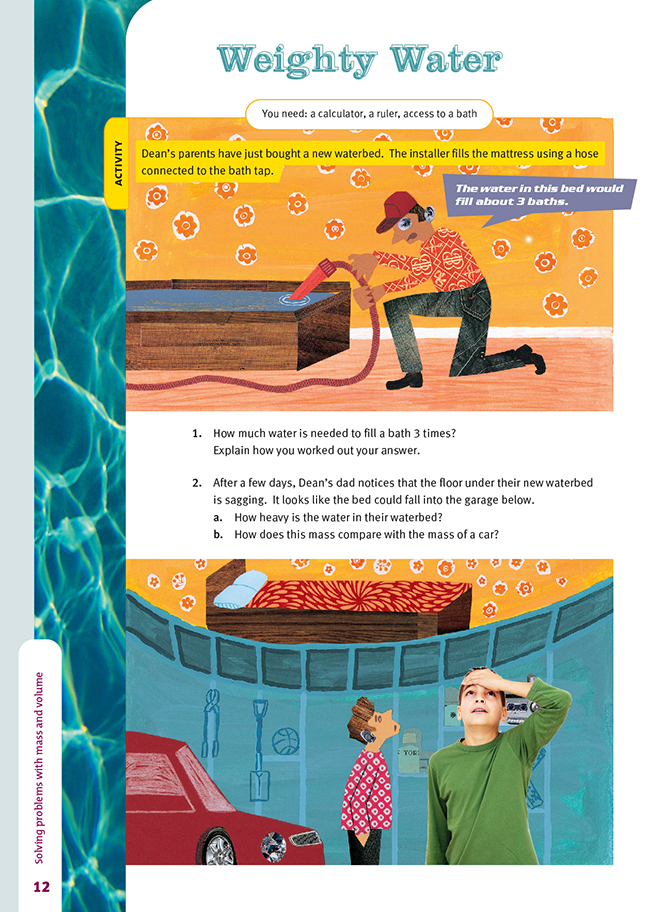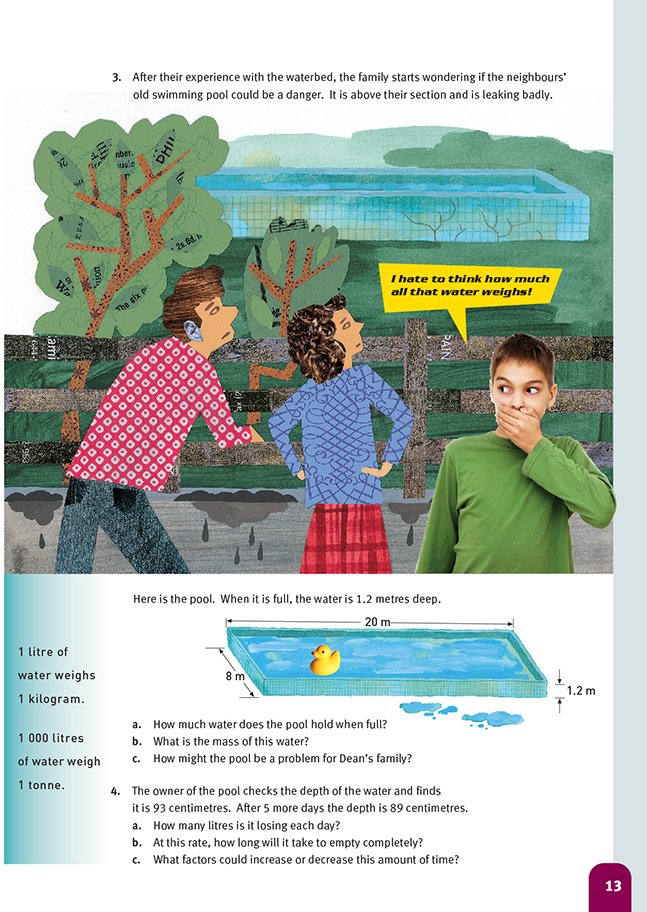Weighty Water
This is a level 4 measurement strand activity from the Figure It Out series.
A PDF of the student activity is included.
Click on the image to enlarge it. Click again to close. Download PDF (336 KB)
solve problems involving mass and volume
calculator, ruler
access to a bath
FIO, Level 4, Measurement, Book One, Weighty Water, pages 12-13
The previous activity was designed to help students gain a sense of area, measured in hectares. This activity is designed to give them a feel for volumes and the mass of water. It also reinforces the processes for calculating volume and mass.
The students need to be given time to find out the volume of a (standard) bath. This could be done as a home activity the night before. Given that any bath has a sculpted shape, this involves rather more than simply finding the bath’s external dimensions. The students could be challenged to come up with a method and asked to report back next day on both the volume and the method used to estimate it. Clarify the fact that in this case, we are using the bath simply as a unit of measurement, so they are to imagine it filled to the rim.
Students who come from homes where the bath is a corner bath or a spa bath can still find its volume, but when they do question 1, they should use the approximate volume of a standard bath, as worked out by their classmates.
Two ways of estimating the volume of a bath are:
- Regard the shape as more or less a cuboid. Use a tape measure to measure the length and breadth at about halfway up the sides (to find an approximation for the median length and breadth) and the depth at a point about halfway along the bath (to find an approximation for the median depth). Multiplying the median length, breadth, and depth gives a satisfactory estimate for the volume.
- Fill the bath from the cold tap, using a 10 litre bucket. Mark the number of full buckets off on a tally chart. (Any students who want to try this should make sure they get their parents’ permission first.)
The vital connections here should be learned by heart and never forgotten:
- 1 000 cubic centimetres = 1 litre
- 1 litre of water weighs 1 kilogram.
These relationships are so precise and convenient because the metric system was designed to be simple and sensible.
Question 2 asks the students to make a comparison between the mass of the water in the waterbed and the mass of a car. It is surprisingly difficult to find the mass of cars, but the Internet is a useful resource. Question 3 applies the same principles of volume and mass to a larger situation.
Question 4 is a more complex scenario, involving rates, and you should work through it before giving it to your students so that you are familiar with the issues. One approach to part a is as follows:
- The depth has gone down 4 centimetres in 5 days. At this rate, it would go down 8 centimetres in 10 days or 0.8 of a centimetre in one day.
- This means that every day, the pool is losing the equivalent of a layer of water 8 metres by 20 metres by 0.8 centimetres. Converting all units to centimetres, 800 x 2 000 x 0.8 = 1 280 000 centimetres cubed.
- 1 000 centimetres cubed is equivalent to 1 litre. So, to convert the volume from centimetres cubed to litres, divide by 1 000 to get 1 280 litres.
Cross-Curricular links
Social Studies
Students could investigate the legal and moral responsibilities of the owner of the leaky pool, along with a consideration of good neighbour protocols. Newspapers and consumer advocate television programmes often have stories about such issues involving neighbours.
Achievement Objective
Demonstrate knowledge and understandings of:
- how and why people exercise their rights and meet their responsibilities (Social Organisation, level 4)
Answers to Activity
1. Answers will vary, taking into account the shape of the bath. A reasonable estimate for a standard bath, filled 3 times, is 700–800 L.
The internal volume of the bath in cubic metres can be estimated by multiplying average length, breadth, and depth. The following measurements are typical
for a standard bath: 0.585 x 1.4 x 0.32 = 0.26 m3
(approximately 1/4 m3 ).
There are 1 000 litres in 1 cubic metre, so 0.26 m3 = 260 L. 3 x 260 = 780 L
2. a. Answers will depend on the answer given to question 1.
1 litre of water has a mass of 1 kg. 780 L has a mass of 780 kg. That is 0.78 tonne (just over tonne).
b. 0.78 tonne is similar to the mass of a small car (or a large bull or 20 bags of cement).
3. a. 8 x 20 x 1.2 = 192 m3
b. The mass of the water is 192 tonnes.
c. If the pool were to burst, the force of the water could cause serious damage to the property below. Even if this did not happen, the seepage of so much water could undermine the foundations of the neighbours’ house.
4. a. 1 280 L. (0.8 x 800 x 2 000 ÷ 1 000. The water is falling 0.8 cm per day. The dimensions of the pool have been converted to centimetres. )
b. 112 days (rounded up). (89 ÷ 0.8 = 111.25)
c. Answers will vary.
Possible reasons for increased time include:
- Water pressure will reduce as the pool empties, leading to a reduced rate of flow.
- Rainfall will add to the amount of water to be emptied.
A possible reason for decreased time is that the crack in the pool may get bigger, leading to a greater rate of flow.

